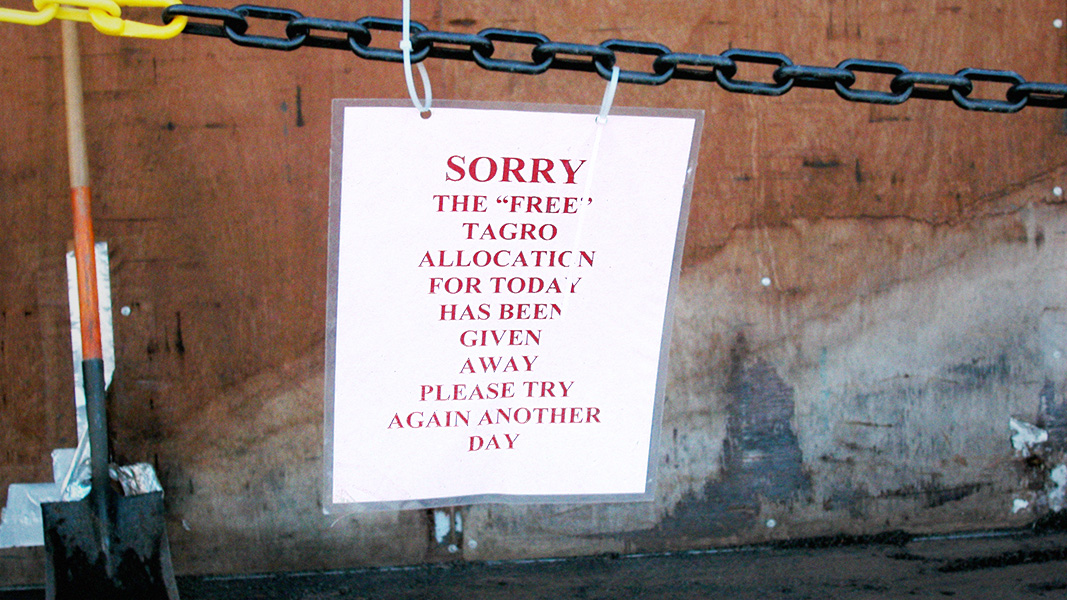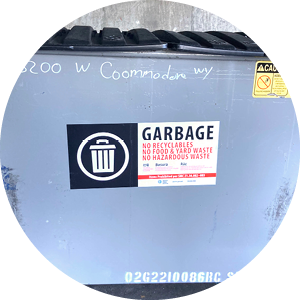Top: Photo courtesy Tagro
 Sally Brown
Sally Brown
The circular economy is a central tenet for survival — the basic principle of waste not want not appropriated by academia and environmental stewardship. In a circular economy, what is waste to you is repurposed as a resource for someone or something else. The valuable components in that waste are captured and reused. Two critical items in that circular economy are nitrogen and phosphorus (N and P). Without them, having food to eat and food waste (regular and digested) to circulate becomes a real challenge. One of the big issues with adapting that principle to our world is that most of us live in cities where life is defined by lines and grids, not circles. A number of studies have looked at nutrient flows to urban areas. The general consensus is that much like the roach motels often found in cities, what goes in does not come out.
In general, we are centralized. We have a grid. We have garbage trucks that go straight to landfills. We have toilets that flush and sewer pipes that lead to centralized wastewater treatment plants (WWTPs). There may come a miracle time in the future when we have the option to go it alone and do it better. Who could have conceived of life without landlines just 20 years ago? With organics this type of transformation is hard to imagine. You need to move materials and not sound waves. Nevertheless, it is often touted as the only route to true circularity. Take for example, the program in Vermont where you pee in a jug instead of a john. Urine diversion and direct reuse is just one example of this golden (pun intended) vision of a sustainable future that leaves the WWTP somewhere alongside the landline.Urban Nutrient Flows
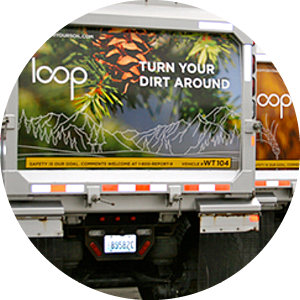
Photo courtesy King County
Most visions of urban circularity do away with the grid. But do we really need to think of the toilet and garbage trucks as the enemy? To test this out, we (myself and two co-authors) looked at nutrient flows in Seattle and Tacoma, Washington. Both cities have been proactive with their wastewater biosolids. Tagro, the biosolids from Tacoma — used to make a range of top dress and topsoil blends — has been ‘making neighbors jealous since 1991’. In Seattle, ‘Loop’ biosolids help you ‘turn your dirt around’. Both cities have green waste collection and composting. Seattle started encouraging residents to add food scraps to the green bin over a decade ago. Now food scraps diversion is required with fines threatened for those who don’t comply. In Tacoma, putting food scraps into the green bin is not required. However, it is certainly A OK.
The last part of this ‘loop’ involves putting those nutrients to use by growing food. In most cities, food comes from the supermarket. Sometimes you can get closer by joining a CSA (community-supported agriculture) and get a box delivered weekly. In areas where CSAs are not available or during the winter, you can just stream Portlandia to get intimate details about the chicken on the menu. This is changing. With the resurgence of urban agriculture in the form of rooftop, backyard and community gardens, and high-tech growing ventures, people can often grow at least some food or can Uber to where it was grown. A number of studies have estimated how much food could be produced in urban areas. Others have measured yields in community gardens. Very few of these have actually measured yields with use of residuals-based amendments. Even fewer have tested different recipes for amendments to find the best mix. Lucky for you, I’ve done a bit of both.
In addition to being proactive about residuals capture, both Seattle and Tacoma are home to centralized and successful community garden programs. One of these, Seattle P Patch, just celebrated its 50th anniversary. The program, located within the Department of Neighborhoods, includes 89 gardens. Harvest Pierce County, housed in the Conservation District, is catching up fast. With close to the same number of gardens and a farm, the program has grown rapidly since its creation just over 10 years ago.
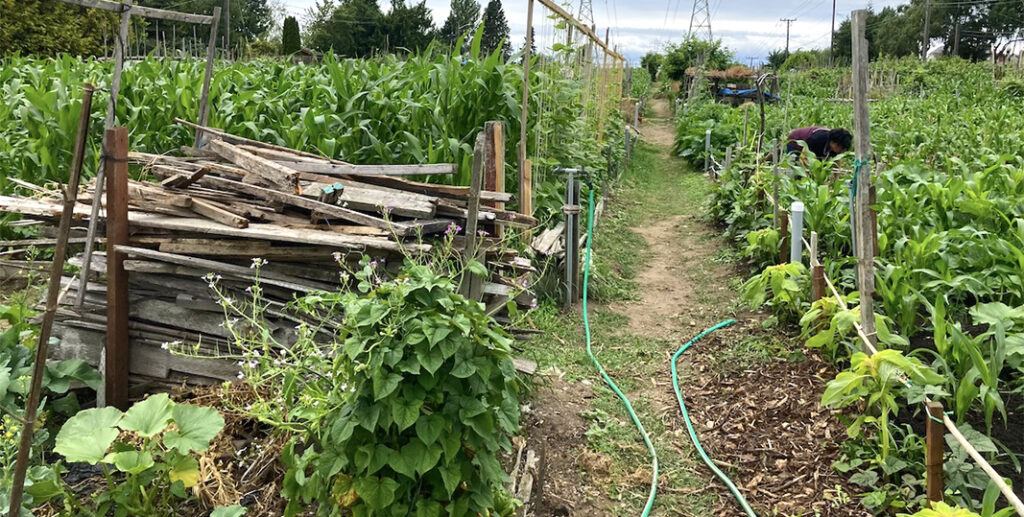
Few research studies have measured yields at community gardens that use residuals-based amendments. Even fewer have tested different recipes for amendments to find the best mix.
For this study we put it all together, starting with how much N and P we need to grow food. Then we tracked recovery rates in food scraps. After that comes a trip to the toilet with estimates of N and P in pee and poop. Nutrient flows into and out of the WWTPs were calculated. Finally, we take this bounty to the community gardens and estimate just how much food can be grown with residuals in each city.
Nutrient Needs
Nitrogen is the most important nutrient for plant growth. It is also critical for humans and animals. A quick primer on N and P is useful to get our discussion started:
Nitrogen: We breathe in N every day with every breath; our atmosphere is over 75% N2 gas. Try to turn that into protein as you breathe and no matter how hard you chant, it just isn’t going to happen. Microbes must have better karma than us humans, as a select few have figured out how to make this transformation. Legumes, or plants like clovers and beans, have worked out an exchange with these microbes and so have access to the mineral N. In the old days, that was how N was added to soils. Most of the N that gets applied to soil has been transformed into a mineral form (ammonia or nitrate) by using energy. Nitrogen fertilization with synthetic fertilizer has exploded in the last century. Currently, we are using too much of this manufactured fertilizer and have far exceeded the planet’s ability to absorb it.
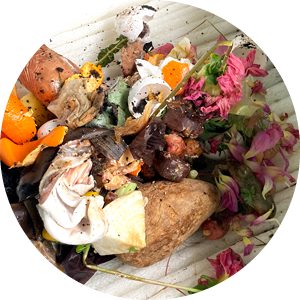 Using recycled N, from manures and uneaten food, is the best way to reduce our dependency on the manufactured stuff. This is better for soils as adding fertilizer alone has been shown to degrade soils. Recycled N is also slow release, reducing the potential for the N to leach through the soil and into groundwater. This form of N also comes with all the other required plant nutrients in the same package. Each kilogram of N as fertilizer costs between 3 and 4 kgs of carbon dioxide (CO2) to produce.
Using recycled N, from manures and uneaten food, is the best way to reduce our dependency on the manufactured stuff. This is better for soils as adding fertilizer alone has been shown to degrade soils. Recycled N is also slow release, reducing the potential for the N to leach through the soil and into groundwater. This form of N also comes with all the other required plant nutrients in the same package. Each kilogram of N as fertilizer costs between 3 and 4 kgs of carbon dioxide (CO2) to produce.
Phosphorus: Phosphorus does not come from the sky. It comes from rocks. And those rocks are running out. The U.S. used to have a lot of P-rich rocks, primarily in Florida and Idaho. Those reserves are nearly gone. Now almost all the world’s P reserves are in the desert south of Morocco. At the same time as we are worried about running out, we are also plagued by years of overuse. Because P is typically tightly bound in soils, farmers were encouraged to add excess for decades. Then the unthinkable happened — excess P started showing up in lakes and rivers. Most of this excess comes from soil particles that have eroded off fields. It has turned multiple bodies of waters slime green. Lake Erie is now a soupy sea of algae. In combination with N, it has created dead zones, or areas depleted of oxygen in the Gulf of Mexico. As with N, previously used P is a way out of this mess. In most cases, recycled P when added to soils is not all available all at once. It is of the slow- release variety. Adding P with organic matter also improves soil properties making that soil less prone to erosion. An article in The New Yorker by Elizabeth Kolbert, “Phosphorus Saved Our Way of Life—and Now Threatens to End It,” provides a recent review of our world P situation.
A recent study quantified how much N the people in Baltimore, Maryland used each year (Dukes et al, 2020). The results varied by where in Baltimore people lived but on average you need 30 kg of N to get by each year. The bulk of this is associated with eating, with 75% of that 30 kg used for meat, dairy/eggs, and crops. Adding yet another reason to limit meat in your diet, 47% of the N used by Baltimore residents went to raising meat for dinner. Considering just crops, each person needs 6.6 kg of N each year. So let’s take that as our baseline.
For P, I found a different study to get an estimate of how much we need to eat each year (Metson et al., 2020). As with N, most of the P we need to eat goes to cows, chickens and pigs. With steak for dinner, each person needs about 4.4 kg P/year. If you limit animal protein and opt for tofu or rice and beans, the crops you eat require about 1.1 kg P to grow.
Remember those numbers — 6.6 kg of nitrogen and 1.1 kg of phosphorus. In Part II, I’ll estimate how much N and P are in food scraps and wastewater and then take it to the programs in Seattle and Tacoma to see how much is actually collected.
Sally Brown, BioCycle Senior Adviser, is a Research Professor at the University of Washington in the College of the Environment.


